Jomsom Nepal - Gateway of Forbidden Kingdom!
The gateway of forbidden kingdom!
The gateway of forbidden kingdom!
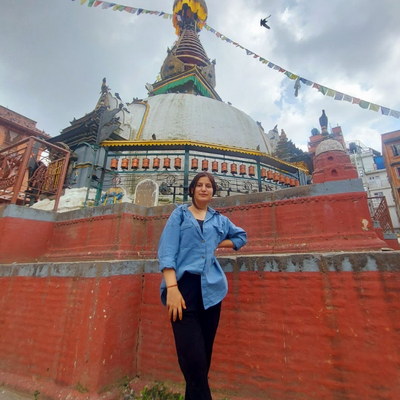
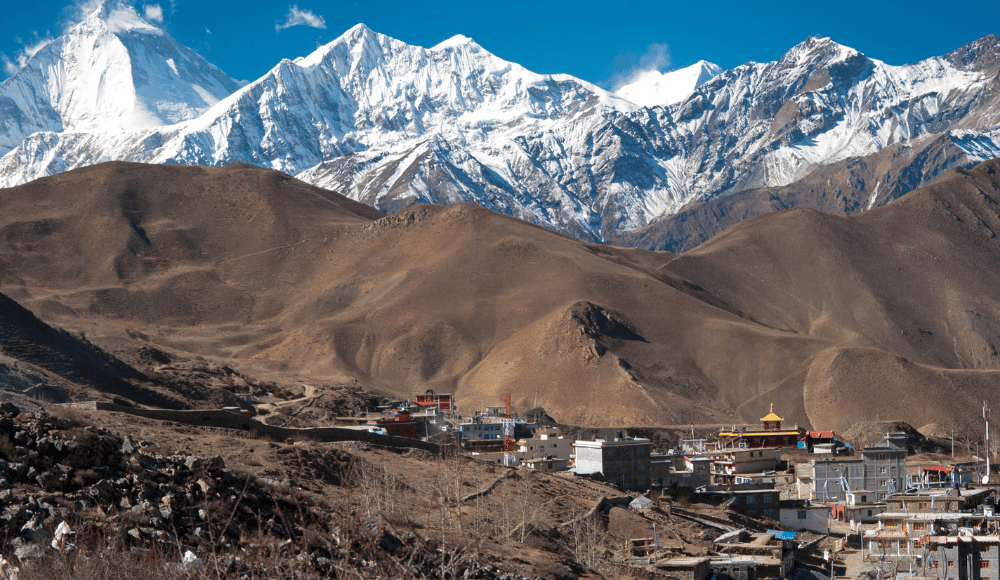
Jomsom of Nepal is a small yet beautiful mountainous city nestled in between the mighty Dhaulagiri and Nilgiri mountain ranges. It is indeed a go-to destination for those who want to get immersed in the admirable religious harmony of Tibetan Buddhism and Hinduism. Diverging cultures and traditions of the multiple ethnic groups along with the unique geography illustrate Jomsom as a perfect hideout to kill some lonely time in the momentous Himalayans.
The hamlets with their unique architecture and design and the apple orchards fencing the surrounding make the Jomsom a hidden jewel of western Nepal. It is also the gateway of multiple trekking trails and routes. One of the most infamous is trekking up to one of the restricted areas of Nepal, Lo Manthang. Nowadays it can be reached easily by four-wheelers and two-wheelers still the trekkers choose to trek over it from Jomsom.
Nepal is a landlocked country hence no sign of seas and oceans, which means no desert too. But you can observe deserts look alike here in Nepal, in one specific place which is Jomsom, Mustang. Sounds astounding right? Yes, it looks like a desert with fairly little vegetation with barren terrains and naked landscapes. And this differentiates Jomsom, Mustang from all the other tourist destinations here in Nepal.
Also, You can see multiple chortens, monasteries and temples in this mighty land which bestows an exquisite view.
The dramatic change of scenery is another exclusive feature of this highland. The domains change rapidly as a river at the bottom, coniferous Pine and some medicinal herbs in the lower belt, naked terrains on its top and the straddling peaks crowning it all. Mainly animal husbandry, the trade of medicinal herbs and tourism is the major source of the economy in this region. Nowadays remittance is also aiding the volume.
Apart from the culture, tradition and geography, Jomsom is also well known as the bustling trade route in the ancient period. Mainly salt used to be traded from the Tibetan Autonomous of China. Later because of some national treaties and all, this activity was halted and till now there is no sign of resuming this.
If you ever get the chance to visit Nepal don't hesitate to explore this unspoilt mountainous city as it offers the perfect fusion of nature, culture, norms and values. You will get a different insight into the traditional Nepali lifestyle of the isolated Himalayan region. Here you could get a chance to peek into the costumes and the artefacts used in the mountainous region which totally varies from the ones in the bustling city of Kathmandu and Pokhara.
Also, the feeling of being on the moon is another treasuring point regarded in this mountainous territory. Not just blabbering around, you can actually feel like it when you get to this heavenly place. I personally felt this utter satisfaction with massive pleasure as soon as I landed my foot on the marvellous Jomsom. So, There is considerably no dispute saying that this is indeed a little utopia. This article here totally hovers over the glam, glory and easy access to the beautiful Jomsom. So, if you are into it and want to learn more about it, feel free to scan this article thoroughly. You will be rewarded with all the way out to your queries and confusion!
Jomsom lies in province no 4, Gandaki province in the district of Mustang. It is surrounded by the neighbouring district Manang in the east, Dolpa in the west, Tibet China in the north and Myagdi in the south. Jomsom is the district headquarter of Mustang district situated in the valley of Kaligandaki and sprawls in the northern region of Pokhara. Standing at an elevation of 2743m, Jomsom is a heaving city in the trans-Himalaya region of Annapurna.
Every year thousands of visitors pay a visit to this trans-Himalaya region. Since there is very little rain it can be visited year round but because of the very close proximity with the several mountainous peaks this region gets freezing cold in the harsh winter months. So, except for this period, this go-to destination can be visited any other time.
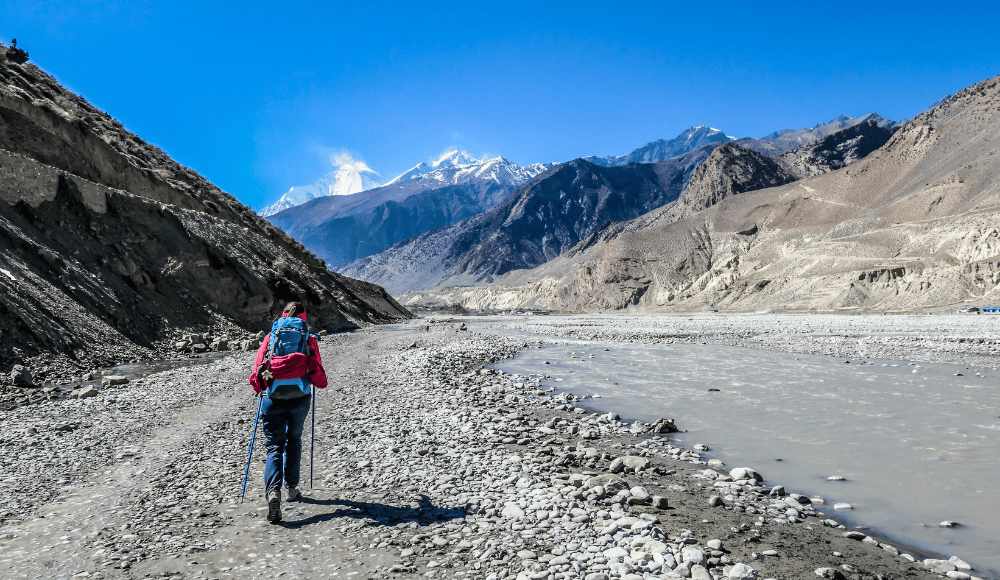
Also, Because of an open boundary with Tibet china in the north, there is still a vast influence of Tibetan culture and tradition in this region. Mainly in the northern part of Jomsom, there are the majority of the Bhotias, Gurung and Magar followed by the Thakalis. While in the southern part resides the Bistas, Thakuri, Dalits and many others. The diverse ethnic groups share diverse practices which is quite a sight to behold which makes the visit to Jomsom even more intriguing.
Get in touch with our experts right away and finalize an experience!
About UsGetting to the marvellous Jomsom is indeed an overwhelming feeling. Everyone wants to get here at least once in a lifetime. And access to this wonderland is neither that difficult either. So, if you want to, you can make a visit nonetheless. Mainly there are three ways of getting to Jomsom, which are By flight, By drive and By Helicopter. The further description of these are cited below:
The daily flight to Jomsom operates from Pokhara. So, to get to Jomsom, first, you need to reach Pokhara from Kathmandu. You can reach Pokhara either by drive or by flight. If you choose a flight, you will board a flight to Pokhara airport from Tribhuvan international airport (TIA), Kathmandu. Alternative to this, if you go with the drive you have to take a daily bus departing from Sorakhutte, Kathmandu. After getting to Pokhara, you have to take another connecting flight to Jomsom. The flight takes about 25 minutes through the gorge of Kali Gandaki to reach Jomsom airport. The Kali Gandaki gorge is considered the deepest gorge in the world. This flight is the easiest way of getting to Jomsom, Mustang though it bears pretty terrifying bumps and risks too.
There is no direct road connection between Kathmandu and Jomsom. So, to reach Jomsom you have to reach Pokhara first. You can reach Pokhara either by drive or air, it's up to you. So the deal here is what after Pokhara? After getting to Pokhara you can go by the drive to reach Jomsom. Moreover, it takes about 7 to 8 hours to reach Jomsom from Pokhara in a four-wheeler Jeep. Also, You are suggested to go with a four-wheeler jeep whenever you choose the drive for Jomsom.
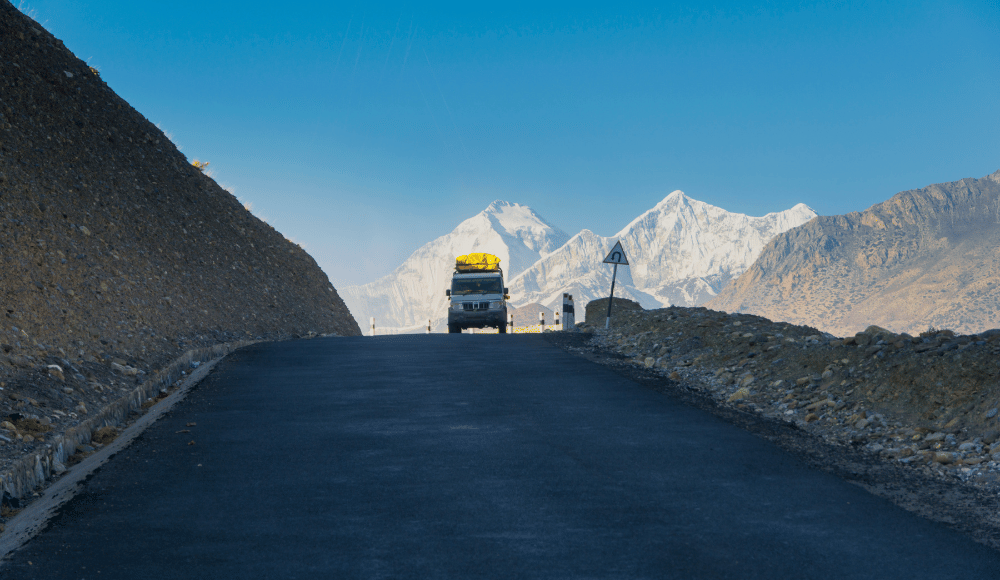
Most describe the drive to Jomsom as a pure thrill and I personally have experienced this. The trails leading to Jomsom are a complete disaster. There are multiple landslides regions hovering above the trails on one side of the trail while there is the rumbling Kali Gandaki river on the other side. And passing in between these two on the very narrow trail is indeed petrifying. On top of that, the continuous threat of stones falling over the trail hunts whenever it rains in this area. So, many prefer the flight over the drive to get to Jomsom.
This is similar to the flight, but the only difference will be on the carrier which will be a small helicopter instead of a large plane. This is the luxurious way of getting to Jomsom and also the easiest way. Here you will get to Tribhuvan international airport (TIA) first, and from there, your journey starts. You will be carried by a small helicopter from TIA. No more than 5 people can board the flight in the same helicopter.
Also, You can not directly reach Jomsom through this. You have to make a transit in Pokhara first, then only fly to Jomsom. It takes around 2 hours for the Jomsom helicopter trip from Kathmandu. During this ride, you can observe the birds-eye view of Kathmandu, Pokhara, towering mountain peaks, and the gorge of Kaligandaki. So you can choose this too if you would like to and obviously if you can afford it as it is more costly than the regular daily flights and drive.
Related trip: Muktinath Helicopter tour from Kathmandu
Jomsom airport is listed as the second deadliest airport after Lukla airport. Because of the various meteorological hazards and topographical constraints this airport is considered the one scary airport. This airport lies at an elevation of 2736m above sea level in the valley of Kaligandaki river.
Most of the flights are arranged in the early morning as the strong wind howls greatly after this period. So, there is no flight after 12 pm, as it is nearly impossible for the flight to take off and land in the late afternoon. Currently, Tara air and Summit air are the only airlines operating the Pokhara- Jomsom airline services. Even if you book the flight in advance, there is no guarantee of your flight taking off and landing at the scheduled time as there is a high chance of flight delay and cancellation because of the adverse weather. Also during the winter months, the airport halts for some months as the visibility is very poor in this period with the gusty winds.
The aircraft from Pokhara dives into the Kali Gandaki gorge at Ghasa and then follows the trails of Lete, Tukuche, Marpha and Jomsom eventually. Most of the mishaps occur in the Kali Gandaki river Valley and then at Jomsom airport. By various surveys, it has been concluded that the adverse local wind flow is the main cause of aircraft crashes. The varying wind levels at the ground level and the boundary level because of the influence of both the Tibetan plateau and Kali Gandaki gorge is the shaded culprit behind the unfortunate.
Ever wonder why you get multiple head turns whenever you mention the name “Jomsom” in a huge crowd? It's because Jomsom is worth every inch of appreciation. Till now, it is able to create a pleasant memory in the hearts of many. Not only the ethnic group’s culture and practice are its only possession, there are several such as Kagbeni, Marpha village, Muktinath temple, Dumba lake and many more. Some descriptions of these beauties are mentioned below:
One of the oldest villages in the scenic Himalayas is the village of Kagbeni. It sits at an elevation of 2804m in the Kaligandaki river valley. It takes about 30 to 40 min to reach Kagbeni from Jomsom, which is approximately 12.3 km. Kagbeni is a junction point from where two trails depart. One leading to the religiously great Muktinath temple and the other towards the once-forbidden kingdom of Lo Manthang. In ancient times, only the old houses were seen within this village but nowadays with growing tourism, modern houses have been built and used for the purpose of lodges and hotels.
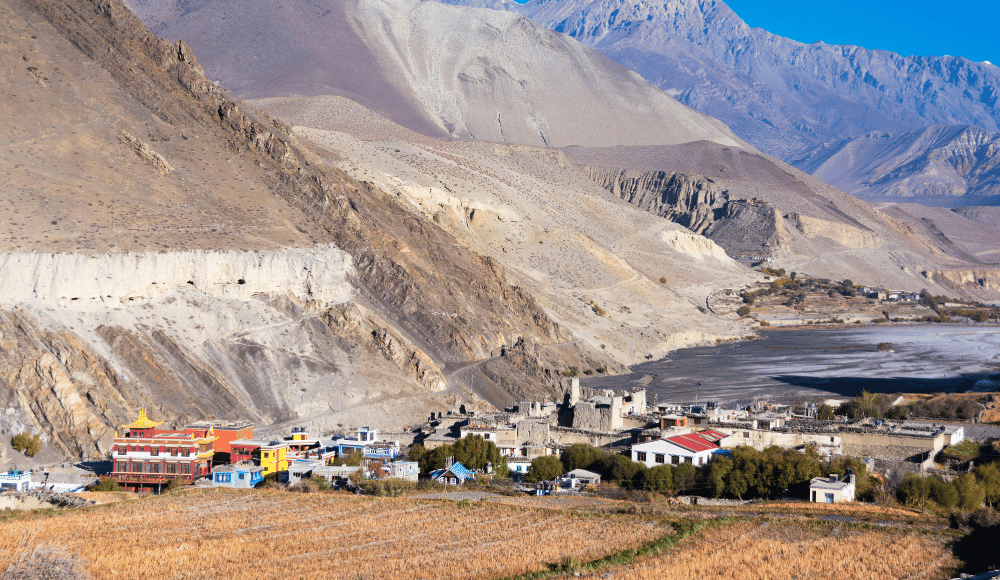
Mainly Kagbeni has got religious significance. As it lies in the trails to Muktinath, it is popular among the people itself. On top of that, it gets hundreds of visitors every year during the Dashain festival. It's because this place is considered sacred for conducting a special ritual honouring the deceased known as Sorha Shraddha. This is the one major rite in the Hindu culture in which the successors pay homage to their ancestors seeking a peaceful afterlife.
Furthermore, as it is relatively closer to the Muktinath temple than the Jomsom, most of the visitors prefer staying overnight here. Then the next early morning they hop on the journey to the religious pillar Muktinath temple. Though most choose to do so, old citizens and pulmonary disease patients are advised not to stay in Kagbeni. It's because there is a high possibility of getting altitude sickness if you directly get to Kagbeni without any practice of acclimatising.
One of the exemplary mountainous villages with breathtaking views and tranquil surroundings is the village of Marpha. This is the village embellished by tradition, art, heritage and history. The layout of the village demonstrates ancient architecture as the houses are inbuilt with mud and stones without any gaps in between. This is to prevent the strong wind that hits this area every single day. Nowadays though the construction of modern houses is growing, it still has not lost its charm because of the adequate presence of traditional ones.
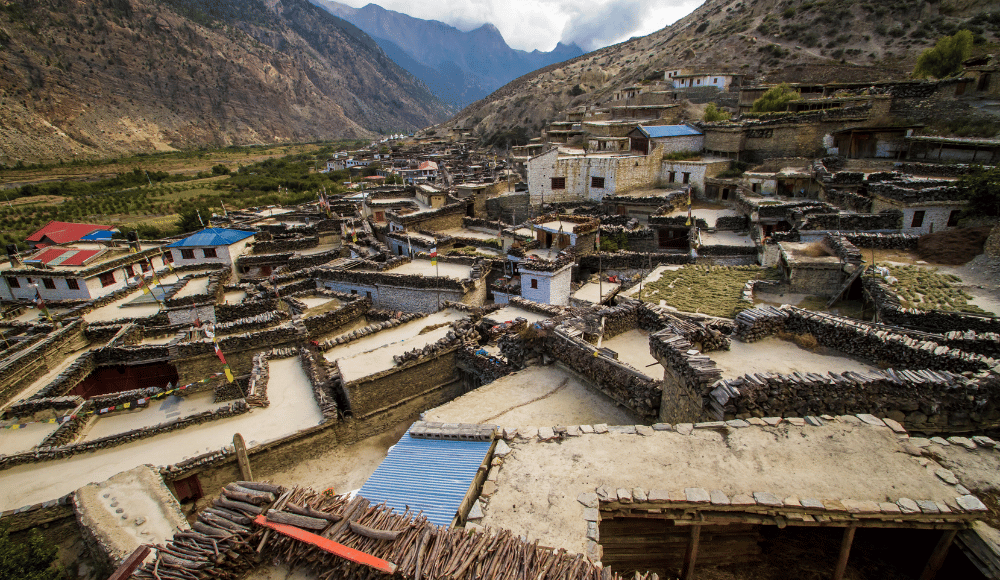
Marpha village has never failed to amaze visitors. The unique house design is the major one. Additional to this, the woods on the roof of all houses catch the visitor's attention. Since they use fire for all of their cooking and other necessary households, they store the wood on the roof of the house. More to this, in the months of December, January and February temperature here drops below 1 deg celsius. So to avert the freezing cold they ignite the fire to warm up the house. Also, You can find the majority of the Thakali community here, so you could get authentic Thakali cuisines here.
This is the one single village in the Mustang district which is free of load shedding. Here electricity is generated from the local hydropower. So, there is no problem with the lights here. To reach Jomsom, first, you have to reach Marpha as Jomsom is only 7.3 km far from Marpha village. This takes around 10 to 15 minutes for a jeep to reach Jomsom. Also, the Marpha village produces the largest number of Apples every year. So, whenever you spot the large orchids of Apples, then it is the magnificent village of Marpha.
One of the mesmerising blessings of beautiful nature in the Mustang district is the lake of Dumba. This lake is situated at an elevation of 2760m from the sea level in Thini village. It takes only 20 to 30 minutes at most to reach this breathtaking turquoise lake in a two-wheeler or four-wheeler from the Jomsom.
This lake is considered sacred and there is a gompa near the lake. There is this superstition that before performing any prayer in this Gompa one should bathe the Gompa idol with the holy lake water, then only follow the other procedure to get the blessing of the divine. So, the locals especially take care of the lake as no one is allowed to swim in this holy water.
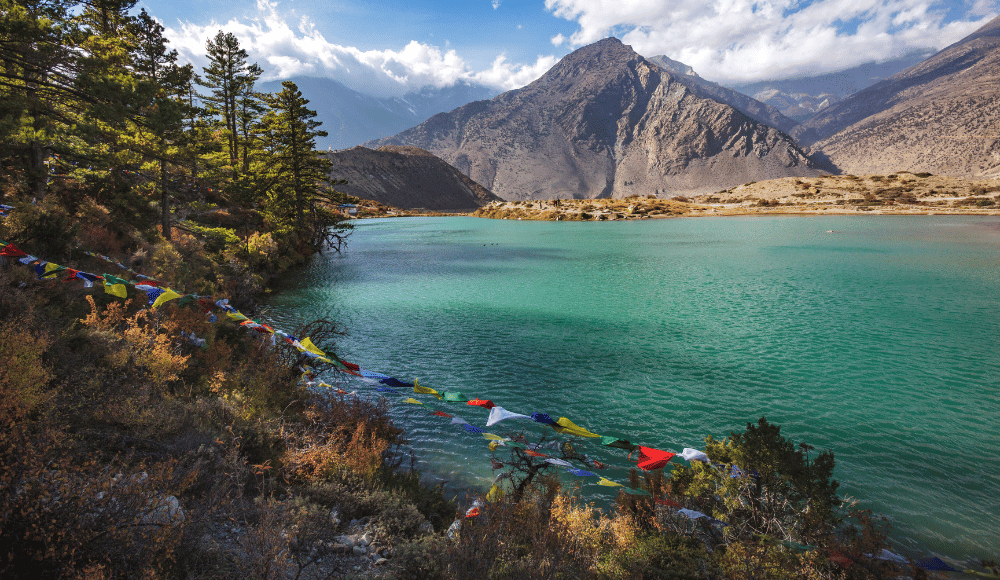
Addition to this, many species of fish can be seen in this lake. But fishing is as strictly prohibited as swimming. The water of this lake is green, hence many call this lake a green water lake too. Except this, one thing makes this lake even more bewitching which is the nearby dense pine forest and the reflection of the Dhaulagiri mountain range in the lake. Not just prating around but this is more than spectacular, more like an angelic one.
Also the hanging prayer flag surrounding the lake territory and the placid environment around grants a total release of the unspoken gloom and dullness within you. So, a visit to this lake is not just about capturing the scenery but also letting go of all the pain and darkness keeping you awake at night.
Believed as a sacred place of salvation, the Muktinath temple is worshipped as one among many forms of the deity Vishnu. It is believed that in this holy ground, lord Vishnu got his curse lifted, hence called the land of Salvation. It is the major pilgrimage site for both the Hindu and Buddhist pioneers. It lies in the foothills of Thorong La mountain pass in the Barhagaun Muktichhetra village in the district of Mustang, Nepal. Muktinath temple is a three-storey pagoda style west faced temple. As it is situated at an elevation of 3710m, on the base of one of the mountain passes of the Annapurna circuit, it is well-explored by trekkers too. So, not only the devotees but also the trekkers trekking in the mountain pass of the Annapurna circuit pay a visit to this holy sanctum.
The origin of the Muktinath temple roots several beliefs and myths. Hindu devotees firmly believe that this temple is one of the major Vaishnav temples in the entire world. In this temple, you can see the stone idol of the deity Vishnu in Padmasana asanas which is the fearless position of the mighty. Mainly this temple is dedicated to Bishnu but not just him alone. It is also considered holy regarding the deity Brahma as there is the eternal flame believed to be lit by the lord Brahma nearby the temple while meditating in classical times.
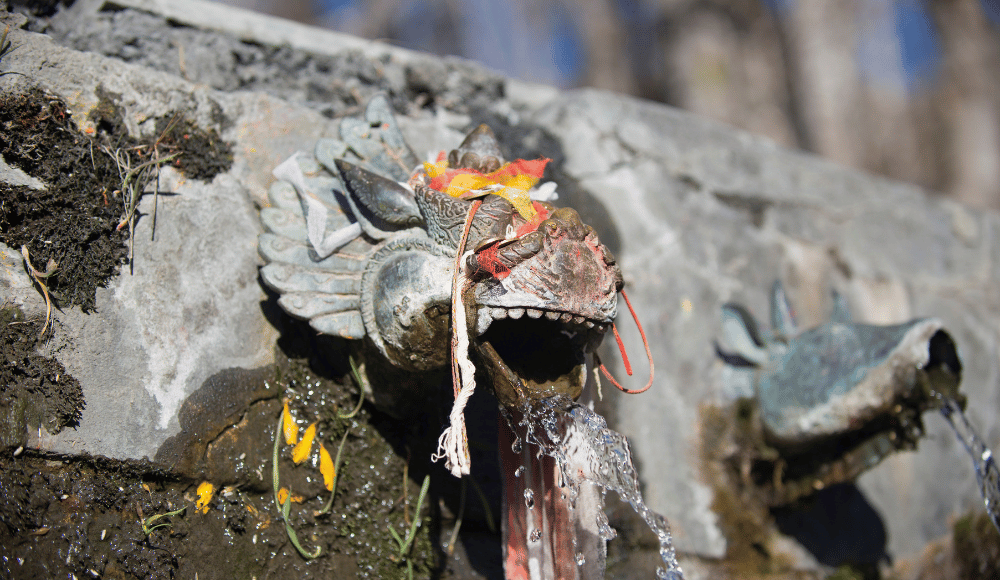
Also, one of the Shaktipeeth, which is one temple of the forehead of the divine Sati Devi is believed to drop here while lord Shiva is wandering around carrying the dead body of his long-gone love in agony. So, this temple is regarded as the one such temple which holds the religious ground of all three mighty gods Brahma, Bishnu and Maheshwar in Hindu mythology.
In regard to Buddhists, they believe that the infamous Guru Rinpoche, who is known as a founder of Tibetan Buddhism meditated here during his journey to Tibet. So, this temple has got prospects for both religions. Hence, you could observe mutual religious tolerance during your visit to this holy shrine.
There are 108 taps with a bullhead-like structure in the courtyard of the temple from which flows the cool mountain water which is considered holy. Also, there are two ponds(Kunda) in front of the temples collectively known as Vishnu Kunda (one Laxmi Kunda and the other the Saraswati Kunda). There is a tradition of taking baths in the 108 taps first and then making a dip in these ponds before offering the prayer. Even during the freezing winter months, devotees perform this as it is believed that after taking these holy baths in this temple you will be granted a free pass from all the sins. Hence, the name Muktinath (Mukti - a means of getting rid of all sins you have committed in this life).
This temple is surrounded by glistening mountains all around. So, if you get there early in the morning, especially at the time of sunrise, you will get buzzed by the beauty in front of you. Everything beams, making you awestruck. Also, on the right side of the temple, there flows a small stream of white water and below the temple flows the great Kali Gandaki river.
Furthermore, the Shaligrams (fossilised ammonites) which are considered very sacred can only be found on the riverbed of the Gandaki river. These holy stones have the imprint of a conch and Chakra embedded in them. If you ever get to Jomsom, don't forget to visit this implausible picturesque as this is only about an hour's drive from Jomsom, Mustang.
Lo Manthang was once a forbidden kingdom. It used to be an independent kingdom ruled by the royal bloodline of Jigme Dorje Palbar Bista. Until 1992, no visits to this restricted zone were allowed. After this time, the visit is made possible by a special permit known as a restricted area permit. A restricted area permit is not like some ordinary trekking permits, it's a special permit only generated by the department of immigration, Nepal. So, to visit Lo Manthang you need to have this along with a local environment officer.
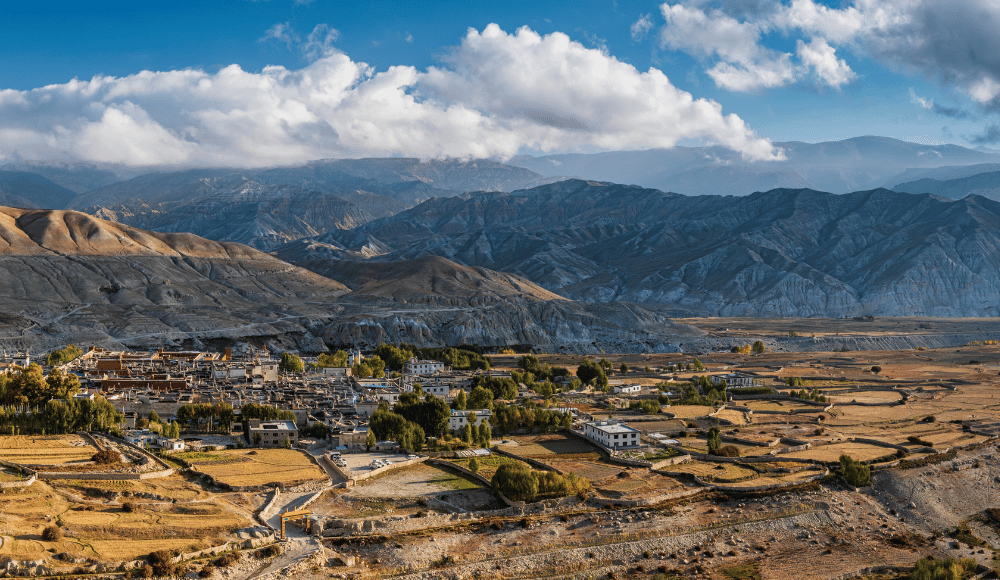
You can reach Lo Manthang either by a four-wheeler or a two-wheeler, also if you would like to you can trek too. It is only 59 km from Jomsom. From Jomsom, you will head for about 30 minutes covering a distance of 12.3km which will lead you to Kagbeni. From Kagbeni two roads depart, one leading to Lo Manthang and the other to Muktinath. You will follow the trails of Lo Manthang from Kagbeni to get there. Also, Lo Manthang is a small Tibetan village reflecting the ancient Tibetan culture with unique lifestyles.
Related trip: Upper Mustang Jeep Tour
It is easier to reach Muktinath from Jomsom. You may be thinking why do people say it is difficult to reach Muktinath then? It's because you reach Muktinath through Jomsom and the road condition until Jomsom is definitely not the best one. So, after Jomsom, there are no such complex trails, comparatively easier and nicer. Hence access to Muktinath from Jomsom is considered an easy one.
It's only a drive of about one and a half hours at most, approximately 25.1 km afar from Jomsom. Muktinath is one infamous shrine bearing the religious significance of both Hinduism and Buddhism. The trails up to Muktinath follow the river bank of Kali Gandaki river. Whenever it rains the trails become pretty slippery, making the drive inconvenient, otherwise on bright sunny days they are all good. Also, you could spot the amazing scenery during your ride to the temple which involves the exquisite view of Nilgiri, Fishtail and many more mountains and the wonderful desert landscapes. So, steal this deal and enjoy the aura it liberates.
Related trip: Muktinath Tour Package by Drive and Flight
You can see multiple hotels in Jomsom, some with ancient designs and some with modern ones. Some of them can't even provide hot water facilities while some of them even bear more luxury. So, it's on your budget which you can afford and your taste which you prefer. Though it lies in a remote zone, you can find anything you want as there is a variety here ranging from low to high.
Nowadays more luxurious hotels are getting built as it has been attracting a large volume of people. But for a longer period, only the lodges with basic amenities are operated in this mountainous city. Also, most of them are operating on a heritage basis demonstrating the old mountainous relics, arts, crafts, comforts and structures. These hotels here offer free wifi facilities with good food and a nice comforter. Also, Some of them even have electrical beds and comforters too. So, don't think lowly of the hotels because of their remote location as they are more advanced and decent than your imagination. Some of the popular well-facilitated hotels in Jomsom, Nepal are listed below:
Om's Home.
Moksha Mustang.
Grand Shambhala.
Trekkers Inn
Only one permit is required to visit Jomsom, Mustang which is the Annapurna Conservation area (ACAP) permit. You can get these permits from the Nepal Tourism Board, Kathmandu. The first check for the permits is done in Ghasa if you are going through the drive and if you are going through a flight, you will have it checked in Jomsom.
Also, if you are heading for Muktinath from Jomsom, then you will have a second check in the information centre in Jomsom. The permit cost is Rs 1000 for the SAARC Nationals and RS 3000 for foreigners. Also, no permits are required for the child below the age of 10. Along with the permit, also carry some id verification as it may help you in some unpredictable incidents too.
|
Annapurna Conservation Area Permit |
Cost (Per Person) |
|
SAARC Nationals |
RS 1000 |
|
Foreigners |
RS 3000 |
The weather in Jomsom is arid, cold and windy. Since it lies just beyond the mountains there is very little rain here. Because of this, you can see the coniferous vegetation in the lower elevation while the thorny plants in the upper one. Also, medicinal herbs like Yarshagumba, Paachauley, Jatamansi and many more can be found in this region.
The temperature in Jomsom goes to 26 degrees celsius in the extremely hot humid season while it drops to -9 degree celsius in the extreme winter months. On top of this, a strong gust of wind blows after the late afternoon every day. It follows till the evening, so there is no flight after 12 pm. Concluding it all, the mornings and evenings in Jomsom are pretty cold while the days are windy.
The best time to visit Jomsom, Mustang can be from March to May and September to November. Though it lies in the rain shadow region and can be visited year-round, cold shivering winter months are not the ideal time to pay a visit to this idyllic beauty.
Related read: Best time to visit Mustang
Some of the notable travel guides and tips for making your Jomsom trip fun and memorable are discussed below.
Even during the hot humid months, this region remains cold in the morning and evening, so always carry warm clothes for your visit.
The strong wind blows from the late afternoon continuously till evening so make sure to pack some scarves and hats too.
If you feel like getting dizzy with some headaches it may be the symptoms of high altitude sickness so ask for ginger garlic soup and warm water asap.
Never forget to bring an ACAP permit as you will have it checked in Ghasa.
If you are a regular consumer of some long-term medications make sure that you include all the required medicines in your backpack.
If you visit some sacred places such as Muktinath, and Dumba lake on your Jomsom trip, follow the community's rules and regulations and don't overdo anything.
Don't get into a fight with the natives, and be more friendly.
our first-hand Himalayan travel experience